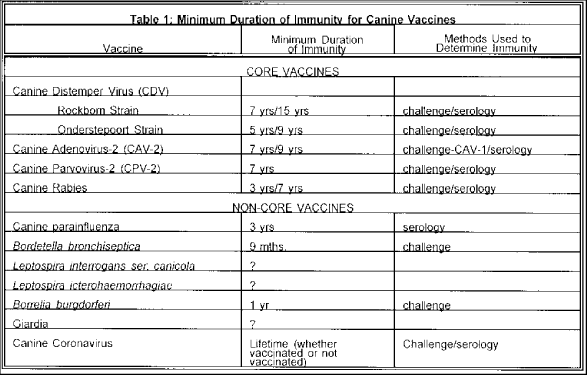Duration of Immunity to Canine Vaccines
What We Know and Don’t Know
Ronald D. Schultz, Professor and Chair
Department of Pathobiological Sciences
School of Veterinary Medicine, University of Wisconsin-Madison
It has been common practice since the development of canine vaccines in the late 1950’s to administer them annually. The recommendation to vaccinate annually was based on the assumption that immunity would wane in some dogs, thus to ensure immunity in the population, all dogs required revaccination since it was not practical to test each animal for antibody. Little or no research has been done to demonstrate that the practice of annual revaccination has any scientific value in providing greater immunity than would be present if an animal was never revaccinated or was revaccinated at intervals longer than one year.

In 1978 we recommended an ideal vaccination program would be one in which dogs and cats would be revaccinated at one year of age and then every third year thereafter (1). That recommendation was based on a general knowledge of vaccinal immunity, especially the importance of immunologic memory and on duration of protection after natural subclinical or clinical infections as well as on limited studies we had performed with certain canine and feline vaccines. Since the mid 1970’s we have done a variety of studies with various canine vaccines to demonstrate their duration of immunity. From our studies it is apparent, at least to me, that the duration of immunity for the four most important canine vaccines (core vaccines) that the duration of immunity is considerably longer than one year. Furthermore, we have found that annual revaccination, with the vaccines that provide long term immunity, provides no demonstrable benefit and may increase the risk for adverse reactions.
We have assessed duration of protective immunity primarily by two procedures; the first is held to be the “gold standard and that is to challenge the vaccinated animal with the virulent organism, the second method is to measure antibody and compare the antibody titer to that which is known to prevent infection (e.g. provide sterile immunity). The studies we report here include challenge studies as well as studies that determine antibody titers. A summary of our results show the following (Table 1).

The minimum duration of immunity data does not imply that all vaccinated dogs will be immune for the period of time listed, nor does it suggest that immunity may not last longer (e.g. the life of the dog). The percentage of vaccinated animals protected from clinical disease after challenge with canine distemper virus, canine parvovirus and canine adenovirus in the present study was greater than 95%.
Although there is much more that we need to know about duration of immunity to canine vaccines the information we have at present provides adequate justification for the vaccination recommendations that I and others have made and continue to make regarding frequency of vaccination (2)
1. Schultz, RD. and F.W. Scott. Canine & Feline Immunization. In: Symposium on Practical Immunology. R.D. Schultz, Ed., Vet Clinics of N. Am., Nov. 1978, W.B. Saunders Co.

